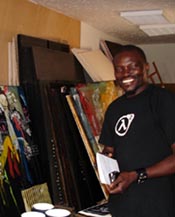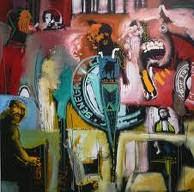 |
| Eva Hesse |
 |
| oil on masonite, no title, 1960 |
 |
| oil on canvas, no title, 1960 |
 |
| Contingent, polymer, 1968 |
 |
| Repetition ..., 1968 |
Eva Hesse was one of the great artists of the 1960s, and her major sculptural works stand out as singular achievements of that era. At once drawing on Minimalist strategies of repetition and seriality, and pushing nontraditional materials toward new modes of expression, Hesse created an art that evoked emotion, absence, and contingency. The large-scale sculptures she created in latex and fiberglass for her only solo sculpture exhibition, Chain Polymers at the Fischbach Gallery in November 1968, secured her reputation. Born in Hamburg in 1936, she and her older sister were sent to Holland on a children's train at the end of 1938. Their parents fled Nazi Germany two months later, and the family came to New York, where Hesse was raised in the German Jewish community of Washington Heights. She wanted to be an artist from an early age and studied at Pratt Institute of Design, the Cooper Union, and the Yale School of Art and Architecture. After completing her studies in 1959, Hesse returned to New York and pursued her art for just over a decade. From The Jewish Museum
"The artist who did the most to humanize Minimalism without sentimentalizing it was Eva Hesse. Dying of brain cancer at thirty-four, an age at which most artist's careers are barely under way, she left a truncated body of work but one of remarkable power: an instrument of feeling that spoke of an inner life, sometimes fraught with anxiety...
 "Spurred by the examples of Jean Dubuffet Joseph Beuys, Claes Oldenburg.... She never wanted to see her work smugly categorized as 'women's art.' Quite the contrary; Hesse wanted it to join the general discourse of modern images, uncramped by niches of gender or race. 'The best way to beat discrimination in art is by art,' she brusquely replied to a list of questions a journalist sent her. 'Excellence has no sex.' From" American Visions" by Robert Hughes
"Spurred by the examples of Jean Dubuffet Joseph Beuys, Claes Oldenburg.... She never wanted to see her work smugly categorized as 'women's art.' Quite the contrary; Hesse wanted it to join the general discourse of modern images, uncramped by niches of gender or race. 'The best way to beat discrimination in art is by art,' she brusquely replied to a list of questions a journalist sent her. 'Excellence has no sex.' From" American Visions" by Robert HughesIn 1967, Hesse discovered latex (a material she knew would eventually deteriorate), fiberglass and polyester resin. Hesse loved the irregular shapes, surfaces and translucency that these materials produced. Hesse often created elaborate, handmade pieces involving obsessive repetition. However, she was not interested in certain technical aspects of sculpture. For many of her later pieces made of metal and fiberglass, she left the fabrication to outside companies. In 1961, she met and married sculptor Tom Doyle.The couple—whose marriage was coming apart—lived and worked in an abandoned textile mill in the Ruhr region of Germany for about a year during 1964-1965. Hesse was not happy to be back in Germany, but began sculpting with materials that had been left behind in the abandoned factory: During the late 1960s, it was popular to remove the appearance of the artist's hand from the work. For Hesse, she did so more for practical reasons than intellectual ones. During this period, when she was creating some of her most well known pieces, she developed brain tumors and continued to work until she became too ill. She then directed assistants to create and install her work. Hesse died in 1970 at the age of thirty four.




















